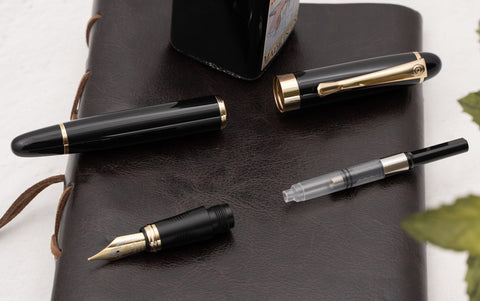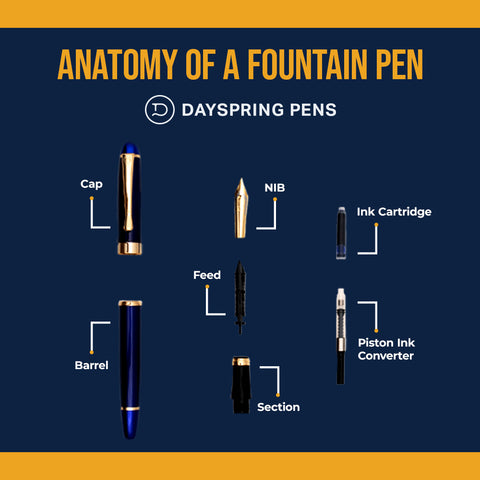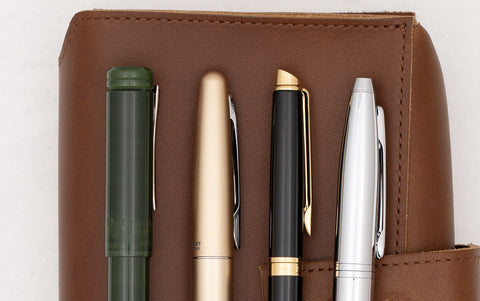How to Clean a Fountain Pen

How to Clean a Fountain Pen
Learning how to clean a fountain pen is essential for anyone who appreciates the elegance and precision of this writing tool.
Dirt and dry ink can really ruin your enjoyment of a fountain pen.
The first sign that you need to clean your pen is when it skips the strokes while you write. If the pen isn’t running out of ink, then cleaning is necessary.
You should clean it often, especially if you didn’t use it for some time.
To tell the truth, to clean it will take some effort on your part. Still, when you bear in mind that a fountain pen lasts longer with proper maintenance, then it’s well worth your time. And the process is even enjoyable: it's fun to just tinker and go through all the little parts that make your pen the unique writing experience that it is.
Cleaning a fountain pen can be kind of like making coffee in the morning. You go through a number of steps (steps which become second nature after a while), and there's a satisfying feeling at every stage. The most satisfying stage, of course, is when you can just sit down and enjoy the finished product.
And don't be scared: the maintenance of your favorite pen is really simple.
Here's a quick step-by-step lesson in pen maintenance:
Basic Steps for All Kinds of Fountain Pens

There are many different and brands and designs of fountain pens on the market. But the cleaning process for the inside of the pen is basically the same for all of them:
- Disassemble the pen.
- Remove the ink cartridge or empty the converter.
- Flush the barrel through with room temperature water until it starts running clear.
- Soak the nib in clean water and leave until the water has become saturated with ink.
- Repeat with clean water until the water remains clear and move all parts onto a cloth or paper towel.
- Let the nib and all other parts dry completely before reassembling the pen.
Ideally, you should repeat this process once a week or before using your pen after being out of use.
| Related Reading: Types of Fountain Pens |
Equipment for Cleaning
Prepare everything you will need to use for cleaning before starting the process. You’ll need:
- Paper Towels: They are very handy since they don’t leave any fibers. These towels can soak the excess water very fast. Still, take care to not scratch the nib, as the paper may have a rough surface.
- Cotton Swabs: Cotton swabs may be useful if you want to clean the barrel. It can easily remove the ink buildup inside of the pen. Before putting the swab into the barrel, soak it in tepid water.
- Syringe: A syringe is very convenient to use when you need to flush the water through the hard-to-reach parts of the pen. Syringes literally inject water into the pen parts. They are available to buy in any drug store.
- Bowls: They are needed for soaking the parts of the pen. The most helpful ones are shallow, wide-mouthed (glasses may be useful for this purpose as well).
Disassembling a Fountain Pen

Before starting the process of cleaning a fountain pen you need to disassemble it completely:
- Remove the cap of the pen.
- Unscrew the pen to separate the nib section from the barrel.
- If a pen has an ink cartridge, remove it (tip: use a pair of tweezers if you can’t grasp it).
- Disassemble the nib section.
Now, your fountain pen is ready for cleaning.
Cleaning of a Cartridge/Converter Fountain Pen
The most common fountain pen for everyday use either has a cartridge or a converter placed in the barrel. So, the pen cleaning process may vary depending on the ink reservoir.
If the Pen Has an Ink Cartridge
Remove the cartridge from the nib. If it isn’t empty, then put it aside into an upright position. You can put a tape on the top of it to prevent spilling the ink or drying it out.
If the ink cartridge is empty, you may replace it with the new one when reassembling the pen.
If the Pen Has a Converter
A converter is a reusable reservoir. It can be refilled with the bottled ink, so don’t throw it away if it’s empty.
You should flush tepid water through the converter to clean it using a syringe or tap. Repeat the process until the water becomes completely clear.
Sometimes ink can remain in the converter. In that case, soak it into the bowl with tepid water. Leaving it in the water for at least an hour will thoroughly clean your cartridge converter.
After rinsing the converter, leave it on a paper towel turned downwards, and let it air dry.
Sometimes, a cotton swab will help you to dry the last bits of moisture before reassembly.
Although cleaning the converter and the barrel is a very important part of the process, this is not the end. There is one more important part to the cleaning of a fountain pen.
| Shop Now: Luxury Custom Fountain Pens |
Cleaning the Nib
A nib is the most delicate part of a fountain pen. The ink runs through it onto the paper. So it should be cleaned thoroughly:

- Run cold water through the nib. Place the nib under the tap or you use a syringe in order to wash it out. If you put the nib under the tap, let it run lightly.
- Don’t use warm or hot water. distilled water works best. Alcohol may damage the nib, so don't be tempted to use that as a cleaning agent.
- Once you’ve rinsed out the nib, put it in a shallow bowl with room temperature water and leave it for 10 minutes.

If the nib has some ink remaining after this process, take a syringe and remove it by gently squeezing water through the section. You should repeat this until ink stops coming through with the water.
After cleaning the nib, leave it in an upside-down position for at least 20 minutes to dry.
Troubleshooting
Occasionally there may be further issues with your fountain pen. In that case, it may require a more thorough cleaning.
You can make cleaning solutions at home:
- Try mixing a teaspoon of vinegar or ammonia into a cup of water.
- Place the nib in the cup and soak it overnight.
- Dry the nib. Put it on a paper towel in an upright position.
Caution: Don't use ammonia if the pen or nib has parts that are made of copper, brass, or aluminum.
How to Store a Fountain Pen
When you finish cleaning the pen, you should store it properly.
- Place it in a pen holder or cup vertically. If you have freshly refilled it with ink and leave it lying down, the ink will dry.
- If you want to store your pen for longer than a week, we recommend that you remove the ink from it and let it dry fully.
- Place the pen in a case for safe storage.

The process described above is applicable to all fountain pens. Still, the frequency of cleaning depends on the pen itself.
| Further Reading: How To Store a Fountain Pen Properly |
It's not a problem to leave them closed with the nib pointed upwards. Cleaning your fountain pen may be possible even if a cartridge or converter is not completely empty. Just make sure that you follow all the steps above.
The following table summarizes common fountain pen problems and how to solve them with various cleaning methods.
| Issue | Solution |
| Ink residue in feed | Soak in pen flush solution and clean with a brush |
| Stubborn stains on barrel | Wipe with a cloth dampened with water or mild soap |
| Nib clogging | Use a bulb syringe to flush with distilled water |
| Rust on metal parts | Gently scrub with a soft toothbrush and rust remover |
Need refills?
We at Dayspring Pens know how frustrating it can be to have your pen let you down at the worst possible moment. Like us, you've probably tried using a pen to write down something important, only to realize that it’s run out of ink.
It's frustrating, to say the least, but it's also an easy problem to avoid. Check out our online store with our affordable fountain pen ink refills.
Get your backup refills today and ensure you don't run out of ink in that all-important moment.
|
|
Daniel Whitehouse is the President and CEO of Dayspring Pens. He uses his expertise with premium writing utensils to create exceptional, intentional products and craft easy-to-understand articles that help both new and experienced users learn more about their writing tools. He lives in Virginia where he and his wife are raising their four children. To learn more about him and his insights about custom engraved gift pens, follow Daniel on LinkedIn. |





